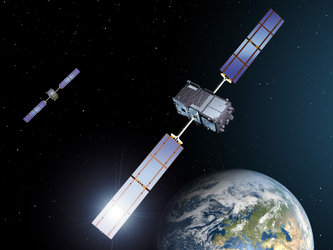Technical details of current Galileo signal
ESA’s first two Galileo navigation satellites in space have achieved their latest milestone, broadcasting the Composite Binary Offset Carrier (CBOC) modulation on E1 Open Service signal.
The E1 Open Service CBOC modulation is the result of multiplexing a wideband signal, BOC(6,1), with a narrow band signal, BOC(1,1), in such a way that 1/11 of the power is allocated, on average, to the high-frequency component.
The signal is the one indicated in the Public Galileo Open Service Signal In Space Interface Control Document (see right hand link).
The satellites enter now in the Routine Operations Phase with continuous signal transmission on E1, E5 and E6 signals.
The signal is the one indicated in the Public Galileo Open Service Signal In Space Interface Control Document (reference web site to be included)
The satellites enter now in the Routine Operations Phase with continuous signal transmission on E1, E5 and E6 signals.
Dummy/spare Navigation Messages are for the time being planned to be broadcast by default on all open signals. The dummy/spare message contents are also described in the Public Galileo Open Service Signal In Space Interface Control Document.
Time of Week and Week Number fields of the broadcast navigation messages are planned to be synchronised with Galileo System Time.
Users intending to perform experiments might experience variations with respect to the above Navigation Message contents due to the current in-orbit validation activities being performed.















 Germany
Germany
 Austria
Austria
 Belgium
Belgium
 Denmark
Denmark
 Spain
Spain
 Estonia
Estonia
 Finland
Finland
 France
France
 Greece
Greece
 Hungary
Hungary
 Ireland
Ireland
 Italy
Italy
 Luxembourg
Luxembourg
 Norway
Norway
 The Netherlands
The Netherlands
 Poland
Poland
 Portugal
Portugal
 Czechia
Czechia
 Romania
Romania
 United Kingdom
United Kingdom
 Slovenia
Slovenia
 Sweden
Sweden
 Switzerland
Switzerland






























